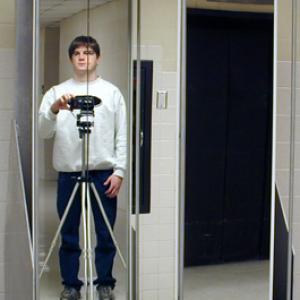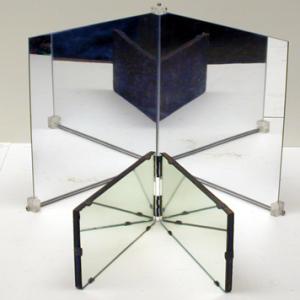College of Liberal Arts & Sciences
6A10.40 - Mirrors - Mirrors at an Angle
Video Credit: Jonathan M. Sullivan-Wood
Clean the mirrors thoroughly before use. When moving the demo use care over bumps so a not to break the flat mirror. Hold a poster with writing on it before the mirrors and the words will be backward and unreadable in the flat mirror but readable in the mirrors set at 90 degrees.
Varying the separation of the mirrors and providing a slight offset should give you a position showing a maximum amount of reflections.
- Jair Lúcio Prados Ribeiro, "Are You Ready, Kids? It's SpongeBob Triclops!", TPT, Vol. 53, #5, May 2015, p. 298.
- Alan J. DeWeerd and S. Eric Hill, "Reflections on Handedness", TPT, Vol. 42, #5, May 2004, p. 275.
- Martin Gardner, "The Unreversed Reflection", TPT, Vol. 34, # 9, p. 563, Dec. 1996.
- Howard E. Evans II, "Ray Tracing with Hinged Mirrors", TPT, Vol. 34, #5, May 1996, p. 314.
- Paul Chagnon, "Animated Displays II: Multiple Reflections", TPT, Vol. 30, #8, Nov. 1992, p. 488.
- Igal Galili, Sharon Bendall, and Fred Goldberg, "Author's Response", TPT, Vol. 30, #2, Feb. 1992, p. 70.
- Theodore H. Ansbacher, "Left-Right Semantics?", TPT, Vol. 30, #2, Feb. 1992, p. 70.
- Igal Galili, Sharon Bendall, and Fred Goldberg, "Some Reflections on Plane Mirrors and Images", TPT, Vol. 29, #7, July 1991, p. 471.
- Michael J. Ruiz and Terry L. Robinson, "Illusions with Plane Mirrors", TPT, Vol. 25, #4, Apr. 1987, p. 206.
- T. H. Ansbacher and Joe Pizzo, "The Non-Reversing Mirror with a Twist", TPT, Vol. 25, #2, Feb. 1987, p. 104.
- R. D. Edge and Edwin R. Jones Jr., "Optical Illusions", TPT, Vol. 22, #9 , Dec. 1984, p. 591.
- Thomas B. Greenslade Jr., "The Author Responds", TPT, Vol. 20, #8, Nov. 1982, p. 504.
- Ronald D. Edge, "In A Mirror, Darkly", TPT, Vol. 20, #8, Nov. 1982, p. 504.
- Mario Iona, "Virtual Mirrors", TPT, Vol. 20, #5, May 1982, p. 278.
- Thomas B. Greenslade Jr., "Multiple Images in Plane Mirrors", TPT, Vol. 20, #1, Jan. 1982, p. 29.
- Lillian C. McDermott, "Double Mirror Experiments: An Extension of the Physics Curriculum", TPT, Vol. 12, #6, Sept. 1974, p. 354.
- R. Kennedy Carpenter, "The Author Replies", TPT, Vol. 12, #6, Sept. 1974, p. 325.
- Bill Franklin, "How Many Images?", TPT, Vol. 12, #6, Sept. 1974, p. 325.
- R. Kennedy Carpenter, "Drake's Law", TPT, Vol. 12, #3, Mar. 1974, p. 133.
- R. Kennedy Carpenter, "A Favorite Experiment", TPT, Vol. 11, #7, Oct. 1973, p. 428.
- Thomas B. Greenslade Jr., "Plane Mirrors at an Angle", AJP, Vol. 90, #8, Aug. 2022, p. 579
- Thomas B. Greenslade Jr., "Adjustable Angle Mirrors", AJP, Vol. 75, #4, Apr. 2007, p. 342.
- Héctor Covarrubias M., "Successive Reflections of a Light Beam on a Pair of Plane Mirrors", AJP, Vol. 58, #6, June 1990, p. 565.
- An-Ti Chai, "The Number of Images of an Object Between Two Plane Mirrors", AJP, Vol. 39, #11, Nov. 1971, p. 1390.
- "O-125. Variable Angle Mirrors", DICK and RAE Physics Demo Notebook, 1993.
- "O-120. Barber Shop & Fixed Angle", DICK and RAE Physics Demo Notebook, 1993.
- G. D. Freier and F. J. Anderson, "Ob-6", A Demonstration Handbook for Physics.
- G. D. Freier and F. J. Anderson, "Ob-4", A Demonstration Handbook for Physics.
- Jodi and Roy McCullough, "Reflection with a Magic Bank", The Role of Toys in Teaching Physics", p. 4.156.
- David Kutliroff, "5. Play with Mirrors", 101 Classroom Demonstrations and Experiments For Teaching Physics, p. 27.
- Martin Gardner, "52. The Unreversed Reflection", Smart Science Tricks, p. 82.
- Martin Gardner, "Un-Reversed Image", Entertaining Science Experiments with Everyday Objects, p. 70.
- Jearl Walker, "6.66. Mirror Labyrinths", The Flying Circus of Physics Ed. 2, p. 267.
- Jearl Walker, "6.64. Images in Two or Three Mirrors", The Flying Circus of Physics Ed. 2, p. 265.
- Jearl Walker, "5.27. Bike Reflectors", The Flying Circus of Physics with Answers.
- "7.1.3. Multiple Images", Cunningham and Herr, Hands-On Physics Activities with Real Life Applications, p. 439.
- Christopher P. Jargodzki and Franklin Potter, "42. Corner Mirrors", Mad About Physics, p. 15, 166.
- Ron Hipschman, "Corner Reflector", Exploratorium Cookbook III, p. 170.1 - 170.3.
- Robert Ehrlich, "P.2. Multiple Images Between Two Inclined Mirrors", Turning the World Inside Out and 174 Other Simple Physics Demonstrations, p. 178 - 179.
- Julius Sumner Miller, Q9 & A9, Millergrams I – Some Enchanting Questions for Enquiring Minds, p. 19 & 78.
- Julius Sumner Miller, Q10 & 13, A10 & 13, Millergrams I – Some Enchanting Questions for Enquiring Minds, p. 20 & 21 & 78 & 80.
- Julius Sumner Miller, Q16 & A16, Millergrams I – Some Enchanting Questions for Enquiring Minds, p. 22 & 81.
- Joseph Frick, "#158 - Plane Mirrors", Physical Technics: Or, Practical Instructions for Making Experiments in Physics and the Construction of Physical Apparatus with the Most Limited Means", p. 188.
Disclaimer: These demonstrations are provided only for illustrative use by persons affiliated with The University of Iowa and only under the direction of a trained instructor or physicist. The University of Iowa is not responsible for demonstrations performed by those using their own equipment or who choose to use this reference material for their own purpose. The demonstrations included here are within the public domain and can be found in materials contained in libraries, bookstores, and through electronic sources. Performing all or any portion of any of these demonstrations, with or without revisions not depicted here entails inherent risks. These risks include, without limitation, bodily injury (and possibly death), including risks to health that may be temporary or permanent and that may exacerbate a pre-existing medical condition; and property loss or damage. Anyone performing any part of these demonstrations, even with revisions, knowingly and voluntarily assumes all risks associated with them.

